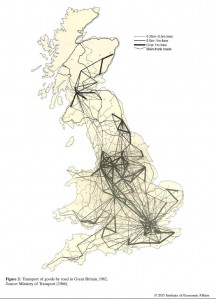Rowan Moore’s [amazon_link id=”1447270185″ target=”_blank” ]Slow Burn City: London in the 21st Century[/amazon_link] is a sort of lament for London, which the book praises for its vibrant, cosmopolitan, energetic, creative dynamism – and portrays as destroying the foundations of this success. The reason for this is obvious: the fact that successive governments have allowed global capital to turn the city into a safe deposit box of property, making it too expensive for most Londoners to buy or even rent a home in, and steadily emptying out the city.
[amazon_image id=”1447270185″ link=”true” target=”_blank” size=”medium” ]Slow Burn City: London in the Twenty-First Century[/amazon_image]
The early chapters give examples of the kind of home building that took place in London in previous generations, the mix of private speculation and public policy that created millions of homes. This was clearly a mixed record but the book argues that little of that was to do with the architecture and planning of the now-notorious post-war to 1960s council estates, and much with social and economic policies. One testament to that is the way those much-criticised flats have joined the market for desirable properties, even in the now-hipste East End. What’s more, as Moore writes: “When riots took place in the Victorian streets of Brixton, nobody blamed the architecture.”
Some of the argument is familiar but I learned new things – for example that until 1951 housing was the responsibility of the Ministry of Health; and that John Stuart Mill had been one of the leading campaigners for keeping London’s parks open and public. The book is a good read and is packed with pictures well selected to illustrate the arguments.
When it comes to the present day, the book sees government welfare policy – keenly implemented by the recently-departed Iain Duncan Smith – as wholly topsy turvy. The government asks why taxpayers should subsidise benefit claimants to live in London. “This is the wrong question – what should be challenged is why living in London has become a luxiry item, even for modest homes in unglamorous areas, and for people who have spent their lives in the city.” He correctly points out that the private market will not fix the housing crisis because private developers will never build more than they can sell quickly, and will never increase supply enough to bring prices down. In a very apt term, he says London is suffering from the ‘necrotizing fasciitis of residential value.’
The fortunes of cities rise and fall. London’s fortunes will decline now unless it fixes the housing crisis. Only the rich can afford to buy homes in the city now – even young professionals cannot get on the housing ladder, never mind teachers and cleaners and baristas; and too many of the purchasers are overseas investors with no interest in the life of the city. Moore ends the book with a manifesto which sits alongside others including Bridget Rosewell’s [amazon_link id=”1907994149″ target=”_blank” ]Reinventing London[/amazon_link] and Kate Barker’s [amazon_link id=”B00NXX6H3U” target=”_blank” ]Housing: Where’s The Plan[/amazon_link]. The ideas are both sensible and depressingly idealistic in the sense that one cannot see this government – or any realistic alternative – agreeing on the need for the social building of new homes, including on some green belt, on a scale that will lead to a decline in prices. But without people, a mixture of people from the entire social scale, a city is a museum, not an economic dynamo.



